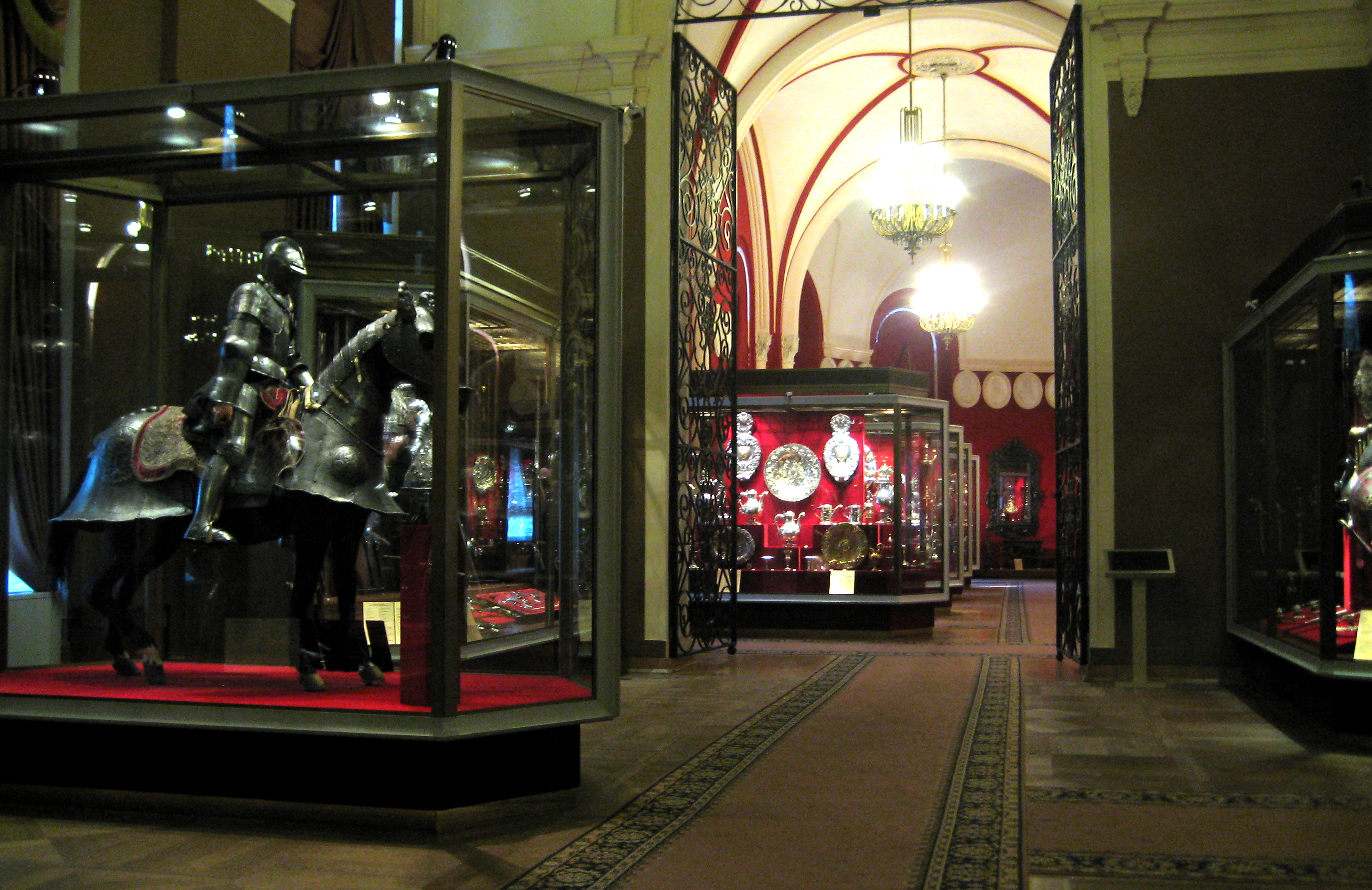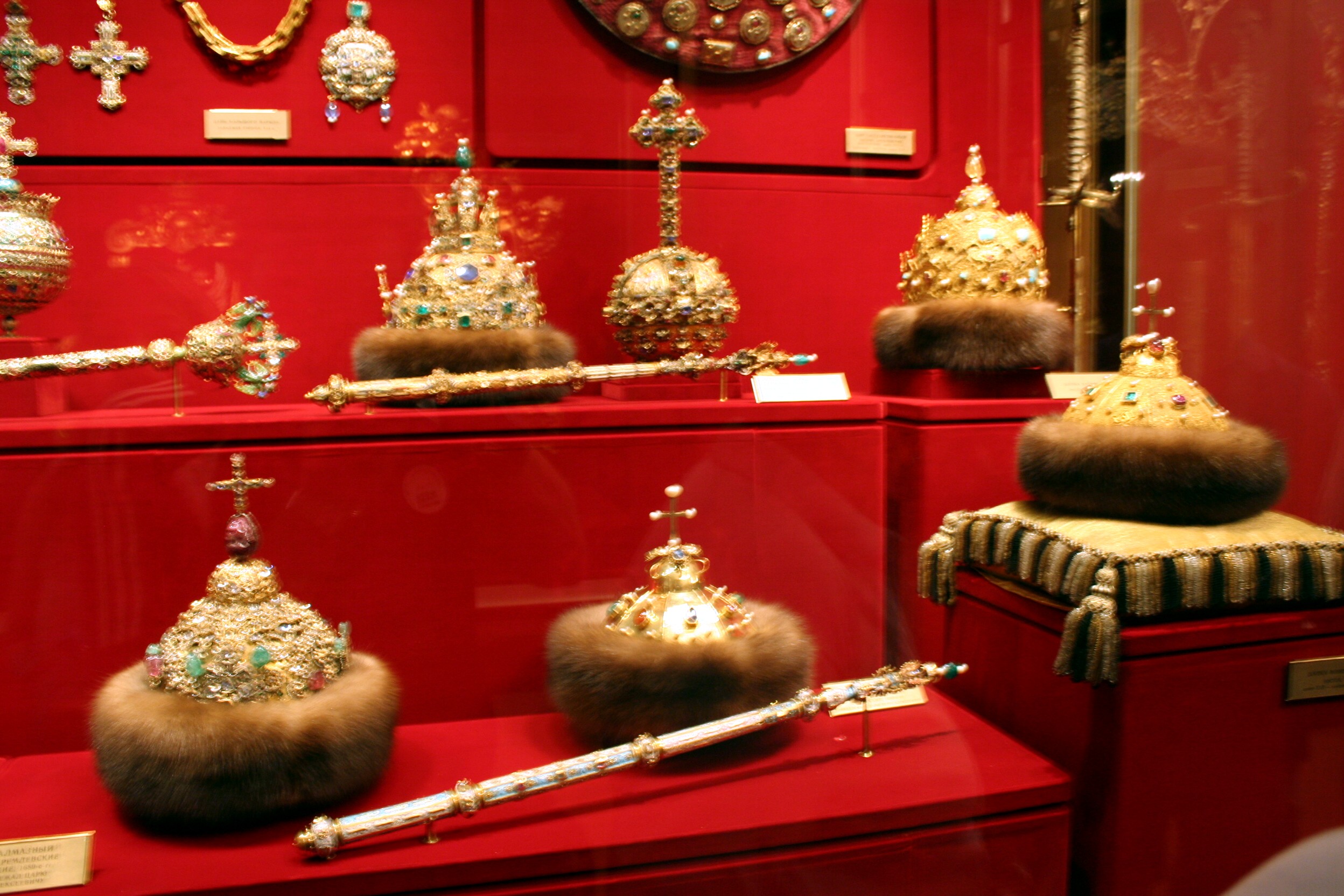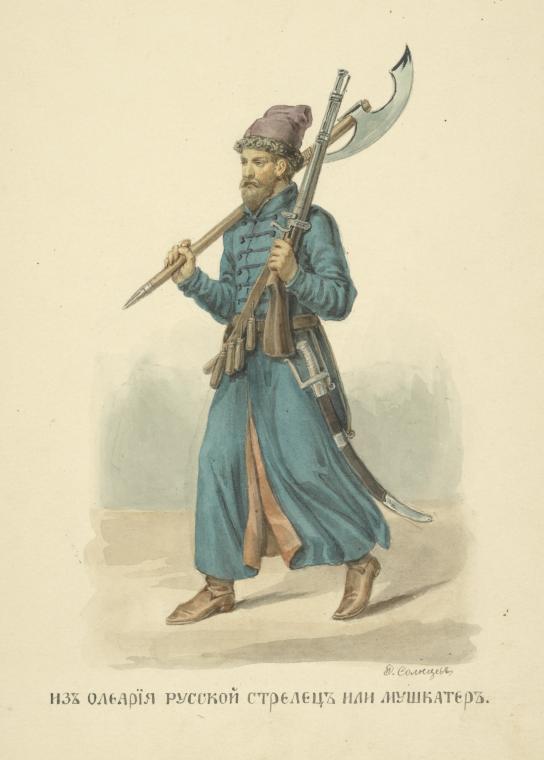|
Ivan V Of Russia
Ivan V Alekseyevich (russian: Иван V Алексеевич; – ) was Tsar of Russia between 1682 and 1696, jointly ruling with his younger half-brother Peter I. Ivan was the youngest son of Alexis I of Russia by his first wife, Maria Miloslavskaya, while Peter was the only son of Alexis by his second wife, Natalya Naryshkina. Ivan's reign was solely titular because he had serious physical and mental issues. Early life and accession Ivan V was born in 1666 in Moscow, the youngest son of Tsar Alexis and Maria Miloslavskaya. Only two of his older brothers survived childhood; his eldest brother, Alexei, died aged 15 in 1670, therefore his second brother, Feodor, became tsar upon the death of their father. When Feodor died in 1682 without leaving an heir, Ivan, who was thought to be "infirm in body and mind", was passed over in favor of his younger half-brother, Peter. The church and the Naryshkins (family of Peter's mother, Natalya Naryshkina) supported Peter's ascension ... [...More Info...] [...Related Items...] OR: [Wikipedia] [Google] [Baidu] |
Natalya Naryshkina
Natalya Kirillovna Naryshkina (russian: Ната́лья Кири́лловна Нары́шкина; 1 September 1651 – 4 February 1694) was the Tsaritsa of Russia from 1671–1676 as the second spouse of Tsar Alexis I of Russia, and regent of Russia as the mother of Tsar Peter I of Russia (Peter the Great) in 1682. Life Coming from a Russian noble family of Tatar descent, daughter of Kirill Poluektovich Naryshkin (1623–1691), and wife Anna Leontyevna Leontyeva (d. 1706, daughter of Leonty Dimitriyevich Leontyev and spouse Praskovya Ivanovna Rayevskaya who died in 1641), she was brought up in the house of the great Western-leaning boyar Artamon Matveyev. She was given a freer and more Western-influenced upbringing than most Russian women of the time. Tsaritsa In March 1669, Tsar Alexis Mikhailovich's first wife, Tsarina Maria Miloslavskaya, died during the birth of what would have been her fourteenth child. Despite their number, few of Alexis and Maria's children ... [...More Info...] [...Related Items...] OR: [Wikipedia] [Google] [Baidu] |
Ivan V Of Ryazan
Grand Prince Ivan V of Ryazan (Ivan Ivanovich, russian: Иван Иванович Рязанский) (1496 – 1533 or 1534) was the last nominally independent ruler of Ryazan Principality. Ivan V of Ryazan was the only son of Prince Ivan Vasilievich and his wife, Agrippina (Agrafena) Vasilyevna, Princess Babich-Drutskaya. Domestic affairs After the death of his father in 1500, he became the nominal ruler under the regency of his grandmother Anna Vasilievna and then, after her death in 1501, of his mother.Кузьмин А.В. Ивано Иванович//Большая российская энциклопедия//https://bigenc.ru/domestic_history/text/1998271 During the regency, the principality was under strong influence of the Grand Duchy of Moscow. In 1503, unsuccessfully, he and his mother, attempted to return the Ryazanian lands passed to Moscow by Prince Fyodor, his uncle. In 1507, Vasily III, attempted to reinforce Ryazanian lands in his authority; he appointed ... [...More Info...] [...Related Items...] OR: [Wikipedia] [Google] [Baidu] |
Coregency
A coregency is the situation where a monarchical position (such as prince, princess, king, queen, emperor or empress), normally held by only a single person, is held by two or more. It is to be distinguished from diarchies or duumvirates such as ancient Sparta and Rome. Co-principality is a distinct but related system employed in contemporary Andorra, where monarchical power is formally divided between two rulers. Historical examples Coregencies were common in the Hellenistic period; according to one scholar, they "can usually be explained as a means of avoiding crises of succession or internal conflict, and of strengthening dynastic identity and ideology." Other examples include the coregency of Frederick I of Austria and Louis the Bavarian over the Kingdom of Germany. ''Jure uxoris'' Kings in Kingdoms such as Spain and Portugal can also be found ( Ferdinand V and Isabella I of Castile, Philip I and Joanna of Castile, Peter III and Maria I of Portugal, etc.). In Navarre, ... [...More Info...] [...Related Items...] OR: [Wikipedia] [Google] [Baidu] |
Kremlin Armoury
The Kremlin Armoury,Officially called the "Armou/ory Chamber" but also known as the cannon yard, the "Armou/ory Palace", the "Moscow Armou/ory", the "Armou/ory Museum", and the "Moscow Armou/ory Museum" but different from the Kremlin Arsenal. (russian: Оружейная палата) is one of the oldest museums of Moscow, located in the Moscow Kremlin, now a part of Moscow Kremlin Museums. The Kremlin Armoury originated as the royal arsenal in 1508. Until the transfer of the court to St Petersburg, the Armoury was in charge of producing, purchasing and storing weapons, jewelry and various household articles of the tsars, and valuables stolen from occupied countries. The finest Muscovite gunsmiths (the Vyatkin brothers), jewelers (Gavrila Ovdokimov), and painters ( Simon Ushakov) used to work there. In 1640 and 1683, they opened the iconography and pictorial studios, where the lessons on painting and handicrafts could be given. In 1700, the Armoury was enriched with the tre ... [...More Info...] [...Related Items...] OR: [Wikipedia] [Google] [Baidu] |
Regalia Of The Russian Tsars
Regalia of the Russian tsars from the 13th to the 20th centuries of the history of Russia, are the insignia of tsars and emperors of Russia. Some of the artefacts were changed or substituted, the most radical change happened in the 18th century, when Peter the Great reformed the state and transitioned it to European-style monarchy. After the Russian Revolution the great number of the Romanovs' was sold by the Bolsheviks, but the most important coronation regalia were placed in the Kremlin Armoury. Since 1967 they are displayed as a part of Diamond Fund permanent exposition. Oldest Russian regalia From the 13th up to the end of 14th century the main insignia of knyaz power were the decorated barmas and the knyaz belts. A barma is a neck-piece or a mantle made of gold, encrusted with gems and diamonds. Such treasured items were hereditary and closely connected to the knyazs' names, they were always mentioned in the wills. The Barmas Barmas of Old Ryazan were produced by ... [...More Info...] [...Related Items...] OR: [Wikipedia] [Google] [Baidu] |
Cathedral Of The Dormition
The Cathedral of the Dormition (russian: Успенский собор , translit = Uspensky sobor), also known as the Assumption Cathedral or Cathedral of the Assumption, is a Russian Orthodox church dedicated to the Dormition of the Theotokos. It is located on the north side of Cathedral Square of the Moscow Kremlin in Russia, where a narrow alley separates the north from the Patriarch's Palace with the Twelve Apostles Church. Separately in the southwest, also separated by a narrow passage from the church, stands the Palace of Facets. The cathedral is regarded as the mother church of Muscovite Russia. In its present form it was constructed between 1475 and 1479 at the behest of the Moscow Grand Duke Ivan III to a design by the Italian architect Aristotele Fioravanti. From 1547 to 1896 the coronation of Russian monarchs took place here. In addition, the cathedral is the burial place for most of the Moscow Metropolitans and Patriarchs of the Russian Orthodox Church; it a ... [...More Info...] [...Related Items...] OR: [Wikipedia] [Google] [Baidu] |
The Coronation Of Ivan V & Pyotr I
''The'' () is a grammatical article in English, denoting persons or things that are already or about to be mentioned, under discussion, implied or otherwise presumed familiar to listeners, readers, or speakers. It is the definite article in English. ''The'' is the most frequently used word in the English language; studies and analyses of texts have found it to account for seven percent of all printed English-language words. It is derived from gendered articles in Old English which combined in Middle English and now has a single form used with nouns of any gender. The word can be used with both singular and plural nouns, and with a noun that starts with any letter. This is different from many other languages, which have different forms of the definite article for different genders or numbers. Pronunciation In most dialects, "the" is pronounced as (with the voiced dental fricative followed by a schwa) when followed by a consonant sound, and as (homophone of the archaic pr ... [...More Info...] [...Related Items...] OR: [Wikipedia] [Google] [Baidu] |
Regency
A regent (from Latin : ruling, governing) is a person appointed to govern a state '' pro tempore'' (Latin: 'for the time being') because the monarch is a minor, absent, incapacitated or unable to discharge the powers and duties of the monarchy, or the throne is vacant and the new monarch has not yet been determined. One variation is in the Monarchy of Liechtenstein, where a competent monarch may choose to assign regency to their of-age heir, handing over the majority of their responsibilities to prepare the heir for future succession. The rule of a regent or regents is called a regency. A regent or regency council may be formed ''ad hoc'' or in accordance with a constitutional rule. ''Regent'' is sometimes a formal title granted to a monarch's most trusted advisor or personal assistant. If the regent is holding their position due to their position in the line of succession, the compound term '' prince regent'' is often used; if the regent of a minor is their mother, she would ... [...More Info...] [...Related Items...] OR: [Wikipedia] [Google] [Baidu] |
Kremlin
The Kremlin ( rus, Московский Кремль, r=Moskovskiy Kreml', p=ˈmɐˈskofskʲɪj krʲemlʲ, t=Moscow Kremlin) is a fortified complex in the center of Moscow founded by the Rurik dynasty. It is the best known of the kremlins (Russian citadels), and includes five palaces, four cathedrals, and the enclosing Kremlin Wall with Kremlin towers. In addition, within this complex is the Grand Kremlin Palace that was formerly the Tsar's Moscow residence. The complex now serves as the official residence of the President of the Russian Federation and as a museum with almost 3 million visitors in 2017. The Kremlin overlooks the Moskva River to the south, Saint Basil's Cathedral and Red Square to the east, and the Alexander Garden to the west. The name "''Kremlin''" means "fortress inside a city", and is often also used metonymically to refer to the government of the Russian Federation. It previously referred to the government of the Soviet Union (1922–1991) and its highest ... [...More Info...] [...Related Items...] OR: [Wikipedia] [Google] [Baidu] |
Streltsy
, image = 01 106 Book illustrations of Historical description of the clothes and weapons of Russian troops.jpg , image_size = , alt = , caption = , dates = 1550–1720 , disbanded = , country = Tsardom of Russia , allegiance = Streltsy Department , branch = , type = Infantry , role = , size = , command_structure = Russian Army , garrison = Moscow , garrison_label = , nickname = , patron = Saint George , motto = , colors = , colors_label = , march = , mascot = , anniversaries = , equipment = , equipment_label = , battles = Siege of Kazan Livonian War Battle of Molodi Polish–Muscovite War (1605–1618) Smolensk WarRusso-Polish War (1654–1667)Great Northern War , battles_label = , decorations = , battle_honours = , battle_honours_label = , flying_hours = , website = , current_commander = , commander1 = , commander1_label = , commander2 = , commander2_label = , commander3 = , commander3_label = , commander4 = , commander4_label = , ... [...More Info...] [...Related Items...] OR: [Wikipedia] [Google] [Baidu] |
Moscow Uprising Of 1682
The Moscow uprising of 1682, also known as the Streltsy uprising of 1682 (russian: Стрелецкий бунт), was an uprising of the Moscow Streltsy regiments that resulted in supreme power devolving on Sophia Alekseyevna (the daughter of the late Tsar Aleksey Mikhailovich and of his first wife Maria Miloslavskaya). Behind the uprising lurked the rivalry between the Miloslavsky and Naryshkin relatives of the two wives of the late Tsar Aleksey (died 1676) for dominant influence on the administration of the Tsardom of Russia. Course of events The death of Tsar Feodor III of Russia on 27 April (7 May N.S.) 1682 triggered the uprising. The Naryshkin brothers of Tsarina Natalia Naryshkina availed themselves of the interregnum and persuaded the Patriarch to proclaim her ten-year-old son Peter as the new Tsar of Russia. In their turn, the Miloslavsky party, which comprised the relatives of the late Tsarina Maria Miloslavskaya, spread rumours that the Naryshkins had strangl ... [...More Info...] [...Related Items...] OR: [Wikipedia] [Google] [Baidu] |
Boyars
A boyar or bolyar was a member of the highest rank of the feudal nobility in many Eastern European states, including Kievan Rus', Bulgaria, Russia, Wallachia and Moldavia, and later Romania, Lithuania and among Baltic Germans. Boyars were second only to the ruling princes (in Bulgaria, tsars) from the 10th century to the 17th century. The rank has lived on as a surname in Russia, Finland, Lithuania and Latvia where it is spelled ''Pajari'' or ''Bajārs/-e''. Etymology Also known as bolyar; variants in other languages include bg, боляр or ; rus, боя́рин, r=boyarin, p=bɐˈjærʲɪn; ; ro, boier, ; and el, βογιάρος. The title Boila is predecessor or old form of the title Bolyar (the Bulgarian word for Boyar). Boila was a title worn by some of the Bulgar aristocrats (mostly of regional governors and noble warriors) in the First Bulgarian Empire (681–1018). The plural form of boila ("noble"), ''bolyare'' is attested in Bulgar inscriptions [...More Info...] [...Related Items...] OR: [Wikipedia] [Google] [Baidu] |




.png)




_-_contrast.jpg)